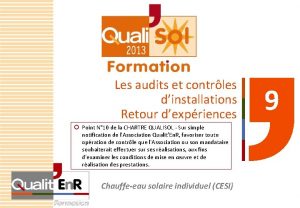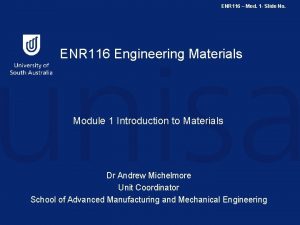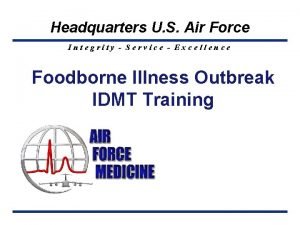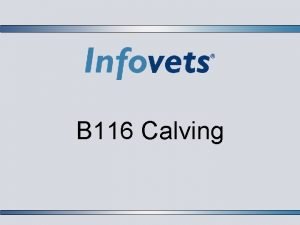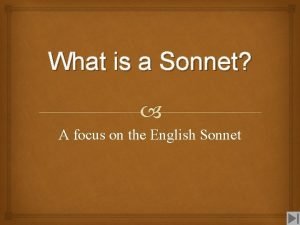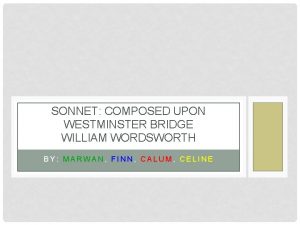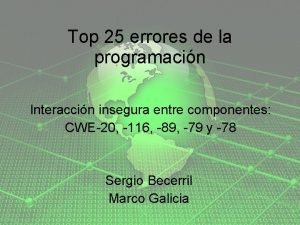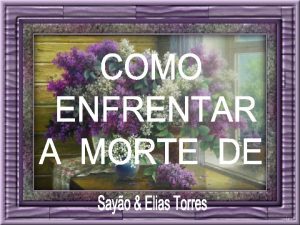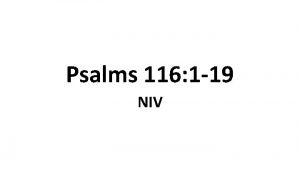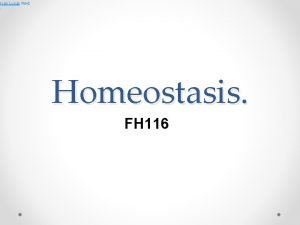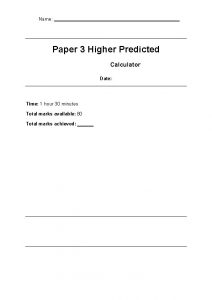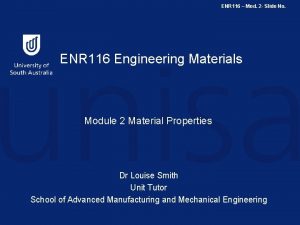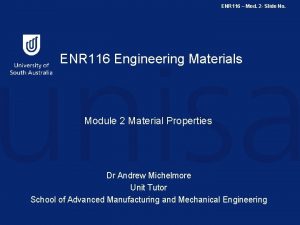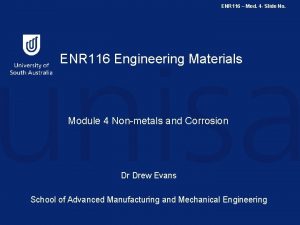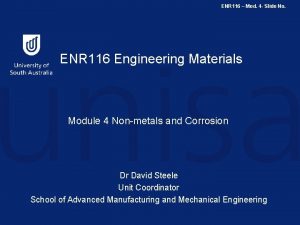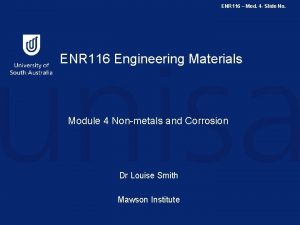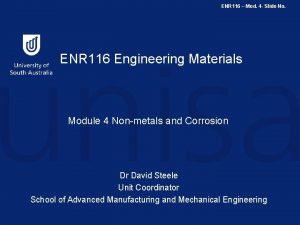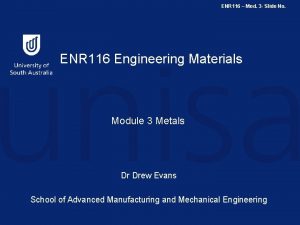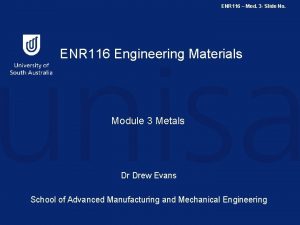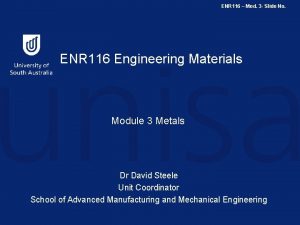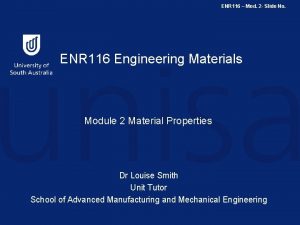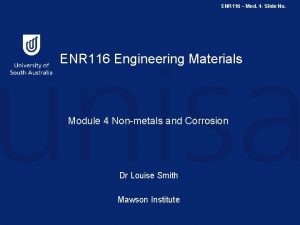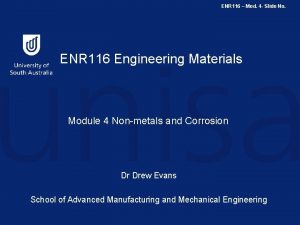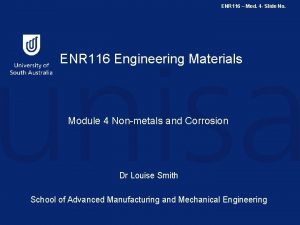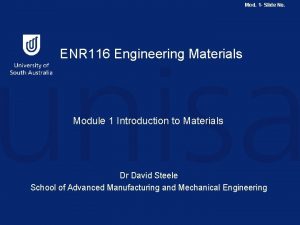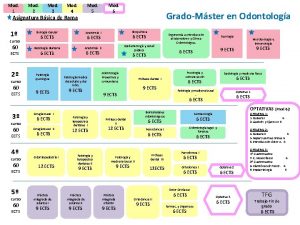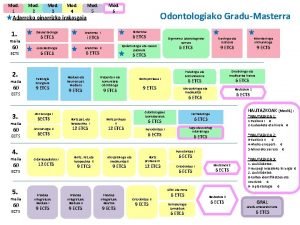ENR 116 Mod 3 Slide No ENR 116



















- Slides: 19

ENR 116 – Mod. 3 - Slide No. ENR 116 Engineering Materials Module 3 Metals Dr David Steele Unit Coordinator School of Advanced Manufacturing and Mechanical Engineering

ENR 116 – Mod. 3 - Slide No. 2 Copyright Notice Do not remove this notice. COMMMONWEALTH OF AUSTRALIA Copyright Regulations 1969 WARNING This material has been produced and communicated to you by or on behalf of the University of South Australia pursuant to Part VB of the Copyright Act 1968 (the Act). The material in this communication may be subject to copyright under the Act. Any further reproduction or communication of this material by you may be the subject of copyright protection under the Act. Do not remove this notice.

ENR 116 – Mod. 3 - Slide No. Alloy fabrication and processing

ENR 116 – Mod. 3 - Slide No. 4 Intended Learning Outcomes At the end of this section, students will be able to: - • Identify some of the common alloy fabrication techniques. • Describe some of the commonly employed heat treatment procedures used to improve the mechanical properties of materials.

ENR 116 – Mod. 3 - Slide No. 5 Alloy classifications Alloy Class Advantages Examples Cast Irons Inexpensive. White, Gray, Ductile Malleable. Steels Large range of strengths, 1016 Plain carbon ductility's. steel, CA 6 N chromium-nickel steel Nonferrous Electrical conductivity. Corrosion resistance. High strength: weight ratio. Noble metals, titanium, copper and aluminium alloys.

ENR 116 – Mod. 3 - Slide No. 6 Metal fabrication How do we fabricate metals? Forming Operations Rough stock formed to final shape • Blacksmith - hammer (forged) • Cast molten metal into mold Cold working • Deformation below recrystallization temperature. • Strain hardening occurs. • Small deformations. Hot working • Deformation temperature high enough for recrystallization. • Large deformations.

ENR 116 – Mod. 3 - Slide No. 7 Metal fabrication methods FORMING CASTING MISCELLANEOUS • Forging (Hammering; Stamping) • Rolling (Hot or Cold Rolling) (wrenches, crankshafts) force (I-beams, rails, sheet & plate) roll die A o blank A d often at elev. T • Drawing force Ao die Ad roll Adapted from Fig. 11. 8, Callister & Rethwisch 8 e. • Extrusion (rods, wire, tubing) die Ao Ad (rods, tubing) Ao tensile force die must be well lubricated & clean force container ram billet die holder extrusion die ductile metals, e. g. Cu, Al (hot) container Ad

ENR 116 – Mod. 3 - Slide No. 8 Metal fabrication methods FORMING CASTING MISCELLANEOUS Casting: Mold is filled with molten metal. Metal melted in furnace, perhaps alloying elements added, then cast in a mold. Common and inexpensive. Gives good production of shapes. Weaker products, internal defects. Good option for brittle materials.

ENR 116 – Mod. 3 - Slide No. 9 Metal fabrication methods FORMING CASTING MISCELLANEOUS Sand Casting: (large parts, e. g. , auto engine blocks) Sand molten metal By Donald Macleod, released under CC BY-NC 2. 0 license What material will withstand T >1600ºC and is inexpensive and easy to mold? Answer: Sand To create mold, pack sand around form (pattern) of desired shape.

ENR 116 – Mod. 3 - Slide No. 10 Metal fabrication methods FORMING CASTING MISCELLANEOUS Investment Casting: (low volume, complex shapes e. g. , jewellery, turbine blades) • Stage I — Mold formed by pouring plaster of paris around wax pattern. Plaster allowed to harden. • Stage II — Wax is melted and then poured from mold—hollow mold cavity remains. • Stage III — Molten metal is poured into mold and allowed to solidify. wax I II III

ENR 116 – Mod. 3 - Slide No. 11 Metal fabrication methods FORMING CASTING Die Casting: High volume. For alloys having low melting Temperatures. MISCELLANEOUS Continuous Casting: Simple shapes (e. g. , rectangular slabs, cylinders). molten solidified

ENR 116 – Mod. 3 - Slide No. 12 Metal fabrication methods FORMING CASTING Powder Metallurgy: (metals w/low ductility's) MISCELLANEOUS Welding: (when fabrication of one large part is impractical) pressure filler metal (melted) base metal (melted) fused base metal heat area contact densify point contact at low T densification by diffusion at higher T unaffected piece 1 heat-affected zone unaffected Adapted from Fig. piece 2 11. 9, Callister & • Heat-affected zone: (region in which the microstructure has been changed). Rethwisch 8 e. (Fig. 11. 9 from Iron Castings Handbook, C. F. Walton and T. J. Opar (Ed. ), 1981. )

ENR 116 – Mod. 3 - Slide No. 13 Thermal processing of metals Annealing: Heat to Tanneal, then cool slowly. • Stress Relief: Reduce • Spheroidize (steels): stresses resulting from: - plastic deformation - nonuniform cooling - phase transform. Make very soft steels for good machining. Heat just below Teutectoid & hold for 15 -25 h. Types of Annealing • Process Anneal: Negate effects of cold working by (recovery/ recrystallization) Based on discussion in Section 11. 7, Callister & Rethwisch 8 e. • Full Anneal (steels): Make soft steels for good forming. Heat to get g, then furnace-cool to obtain coarse pearlite. • Normalize (steels): Deform steel with large grains. Then heat treat to allow recrystallization and formation of smaller grains.

Heat treatment temperature-time paths ENR 116 – Mod. 3 - Slide No. 14 A P a) Full Annealing b) Quenching A c) Tempering (Tempered Martensite) Fig. 10. 25, Callister & Rethwisch 8 e. B 10 0% b) 50 0% % a) c)

ENR 116 – Mod. 3 - Slide No. 15 Hardenability -- Steels Hardenability: Measure of the ability to form martensite. Jominy end quench test: Used to measure hardenability. specimen (heated to g phase field) 24ºC water flat ground Rockwell C hardness tests Adapted from Fig. 11, Callister & Rethwisch 8 e. (Fig. 11 adapted from A. G. Guy, Essentials of Materials Science, Mc. Graw -Hill Book Company, New York, 1978. ) Hardness, HRC Plot hardness versus distance from the quenched end. Adapted from Fig. 11. 12, Callister & Rethwisch 8 e. Distance from quenched end

ENR 116 – Mod. 3 - Slide No. 16 The reason why hardness changes with distance Hardness, HRC The cooling rate decreases with distance from quenched end. 60 40 20 0 1 2 3 distance from quenched end (in) T(ºC) 600 A ® 0% 100% P Adapted from Fig. 11. 13, Callister & Rethwisch 8 e. (Fig. 11. 13 adapted from H. Boyer (Ed. ) Atlas of Isothermal Transformation and Cooling Transformation Diagrams, American Society for Metals, 1977, p. 376. ) 400 200 M(start) A®M rli te a rli Pe lite ea + ar P ite Pe ine ns F te te i ar M ens t 1 ar 0. 1 M 0 M(finish) 10 1000 te Time (s)

ENR 116 – Mod. 3 - Slide No. 17 Hardenability vs. Alloy composition Hardenability curves for five alloys each with, C = 0. 4 wt% C. Cooling rate (ºC/s) 100 10 3 800 T(ºC) 100 4340 80 50 40 4140 40 10 Hardness, HRC 60 20 2 8640 5140 0 10 20 30 40 50 Distance from quenched end (mm) %M 600 TE A B 400 M(start) 200 0 -1 10 M(90%) 10 10 3 5 10 Time (s) Adapted from Fig. 11. 14, Callister & Rethwisch 8 e. (Fig. 11. 14 adapted from figure furnished courtesy Republic Steel Corporation. ) • "Alloy Steels" (4140, 4340, 5140, 8640) contain Ni, Cr, Mo (0. 2 to 2 wt%) • These elements shift the "nose" to longer times (from A to B). • Martensite is easier to form

ENR 116 – Mod. 3 - Slide No. 18 Summary • There a large range of metal forming techniques – both cold and hot working. • Hardenability is a measure of ability of a steel to be heat treated and increases with alloy content.

ENR 116 – Mod. 3 - Slide No. 19 Thank you
 Fiche autocontrole qualit'enr
Fiche autocontrole qualit'enr No enr
No enr Heel and toe polka meaning
Heel and toe polka meaning Slide method factoring
Slide method factoring Afi 48-116
Afi 48-116 Nahl 116
Nahl 116 Psalm 116 1-9
Psalm 116 1-9 116 qq
116 qq Tpcastt sonnet 130
Tpcastt sonnet 130 What is a sonnet
What is a sonnet Sonnet 116 theme
Sonnet 116 theme The alchemist narcissus
The alchemist narcissus 132 sonetas
132 sonetas Wordsworth poem westminster bridge
Wordsworth poem westminster bridge Quran 5 116
Quran 5 116 Cwe-116
Cwe-116 Salmo 116:15
Salmo 116:15 Psalm 34 19 niv
Psalm 34 19 niv Lucasmod
Lucasmod Sami asked 50 people
Sami asked 50 people
